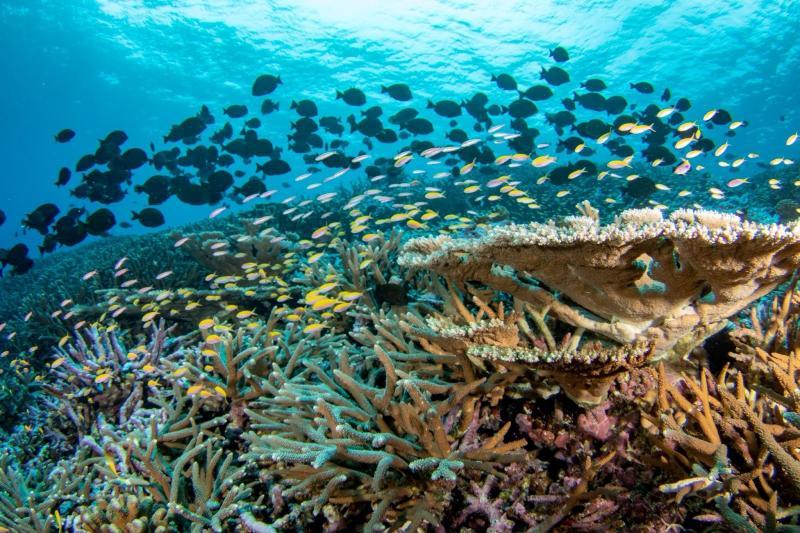
Coral reef fish predictably change with depth, except when people are present
by NOAA Fisheries 2 Dec 2023 18:43 UTC

Fish community on a reef offshore of Baker Island, a remote equatorial island © NOAA Fisheries / Jeff Milisen
A new study reveals that human impacts are changing our understanding of patterns in reef-fish communities across ocean depths.
New research, published in Nature Ecology & Evolution, supports the long-held understanding that reef-fish communities follow certain patterns along different depths. However, this is only true in reef areas that have historically remained free from human activity. These patterns were altered or lost at islands where humans live and where impacts like fishing and habitat loss are present. The study was led by researchers at Bangor University in the United Kingdom in close collaboration with the NOAA Pacific Islands Fisheries Science Center.
Recognizing patterns in reef-fish communities is important for coral-reef management. Testing these long-held understandings as conditions change through time is key to evaluating suitable management approaches.
Revisiting Our Understanding of Reef Ecosystems
One of the oldest described ecological patterns is zonation, which is the distribution of organisms across space. In bodies of water, depth zonation explains how organisms are found at specific depths due to different conditions and interactions with other organisms.
Testing whether and how these patterns are universal in nature is important for developing conservation and management strategies. If these patterns hold true in various places with different groups of organisms, we can use them as trusted guidelines in conservation planning. The ability to test the universality of depth zonation in marine organisms was limited in the past by the lack of standardized observations collected across large areas and the necessary analytical tools.
Lead author, Dr. Laura Richardson of Bangor University's School of Ocean Sciences, explains, "Science is cumulative, building on past work. Now that we have greater computing capabilities, we should be testing these widely accepted but spatially under-validated theories at scale. Human impacts on the environment have increased to the point where these models may no longer predict current-day ecological distribution patterns. Up until recently, our ability to test these core theories was limited by a lack of spatially comprehensive data. Consistent, rigorous, and long-term monitoring from NOAA's National Coral Reef Monitoring Program made our analyses possible, revealing globally relevant insights into our 'natural' world under human pressures, and highlighting the critical role of well-maintained monitoring programs."
Putting Patterns to the Test
The team of researchers used 5,525 fish surveys collected by the National Coral Reef Monitoring Program to confirm the depth-zonation model in coral reefs. These surveys were conducted on nearshore reefs in depths of 1-30 meters across 35 U.S.-affiliated islands in the Pacific.
These islands spanned a large range of environmental and human-driven conditions, including:
- Hawai'i (including the Papahanaumokuakea Marine National Monument)
- Guam
- Commonwealth of the Northern Mariana Islands
- American Samoa
- Pacific Remote Islands Area
"This study emphasizes the importance of the National Coral Reef Monitoring Program and how critical the long-term, sustained monitoring of our nation's coral reefs is. This work would not have been possible without these datasets," shared Dr. Tye Kindinger, a research marine biologist with the science center and National Coral Reef Monitoring Program Fisheries lead in the Pacific.
"By using the same methods to survey across such impressive scales in both space and time, we're able to compare reefs across a broad range of ocean conditions, human impacts, and management actions. Those gradients are key to disentangling which factors have the greatest influence on the resilience of reef communities in the Pacific, and the breadth of each gradient the National Coral Reef Monitoring Program captures in its surveys is what makes the program truly unprecedented."
The research team used the dataset to characterize how reef-fish communities vary across depths. They then tested if these patterns were different in unpopulated versus populated locations.
"Monitoring reefs in remote locations that are difficult to access is another core strength of the National Coral Reef Monitoring Program," said Dr. Kindinger. "Those reefs provide un-fished benchmarks for what natural reef-fish populations look like, and serve as references against which managed populations can be compared."
Humans Disrupt Natural Patterns of Fish
Biomass is a measure of the total weight of fish, which can be higher where fish are more abundant or where there are larger-sized individuals.
In the absence of local human populations, the scientists found support for the depth-zonation model across reef-fish communities across the Pacific.
- The types of fish that eat other fish or plankton increase in biomass at deeper depths, whereas seaweed-eating fish decrease in biomass with depth
- As expected, these observed fish patterns corresponded with the availability of each type of consumer's food supply, which also varied across depth
Among inhabited islands, these clear patterns of fish biomass changing with depth were greatly reduced or entirely absent.
- Fish biomass does not noticeably vary across the entire 30-meter range in depth, and is lower overall compared to fish biomass at uninhabited islands
- This suggests that human impacts on reefs, such as habitat loss or fishing, can disrupt our understanding of connections between fish and their surrounding reef environment, making the patterns in their distribution difficult to predict
Limits of Old Ideas in Changing Seas
This study provides evidence that the ecological theory of depth zonation in reef-fish communities is indeed applicable across an expansive range of coral reefs in the Pacific. However, it also suggests that this long-held concept about natural systems may no longer be valid with increased human impacts.
Dr. Richardson concludes, "This leads to more questions, both about the usefulness of models which represent a world less impacted by human activity, and about how to quantify or model our impact on the natural environment. Now is the time to thoroughly reassess our scientific understanding of the natural world, which increasingly will need to incorporate human impacts."